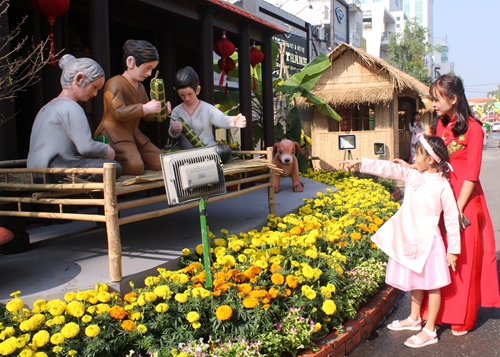In the modern life, the lunar New Year (Tet) of the Vietnamese people has become gradually more realistic and had many new forms of entertainment. However, somewhere, there are people who keep the spirit of the old Tet through writing parallel sentences in spring or restoring Tet folk games. These simple deeds have changed the thinking that traditional Tet in modern times seems to be reserved only for the elderly.
    |
 |
|
The space of a kitchen in the Southern countryside reappeared on Ong Chanh street, Le Binh ward, Cai Rang district, Can Tho city |
We sat on Tra On ferry to reach My Hoa Hung commune, Long Xuyen city, An Giang province where Ho Phu Quoi (also called Ut Quoi) lives. Local people enthusiastically showed us to the house of Mr. Ut Quoi. Greeting us in a typical house in the South with three compartments and two wings was a thin old man with a kind and sincere smile. Talking about his attachment to Tet couplets, Mr. Ut Quoi shared that "I learned the Vietnamese script at the age of 7. When I was 9, my father sent my brothers and me to study the Han script. It took me 13 years to be confident to write parallel sentences."
With the desire to preserve the beauty of the custom of writing pairs of parallel sentences in spring, Mr. Ut Quoi acts as a real scholar. Over the past 40 years, on the full moon of lunar December, he has displayed Chinese ink and red paper on Le Minh Nguon street, where he writes pairs of parallel sentences.
“Writing parallel sentences in the lunar New Year is a habit that has been ingrained in my blood. No matter how busy I am, I still spend time writing these sentences as gifts for my compatriots to display in their houses to enjoy a cozy lunar New Year holiday," said Mr. Ut Quoi.
Wishing to recapture the atmosphere of the old warm and sacred Tet, Nguyen Minh Nhat, a resident in Yen Binh area, Le Binh ward, Cai Rang district, Can Tho city has kept the spirit of Tet in his own way. Nhat recalled that the area where he lived was quite deserted in the past. In the lunar New Year 2018, he asked local households to reappear the scene of Tet and named it Ong Chanh Street.
In the space of Ong Chanh street, visitors can see familiar images that perhaps appear on the occasion of old Tet only, such as Red firecrackers hanging on the porch; a wood-burning stove that mothers often use to cook dishes to offer to ancestors on the lunar New Year holiday; a pot of tet cakes (cylindrical sticky rice cakes) bearing the traditional flavor of the people of the South and expressing the desire of family reunion around the fire; and the scene of apricot flowers blooming in front of the house, signaling the coming of spring; and the scene of an old scholar with his pen starting writing script on first days of the new year.
All of the above images make the space of Ong Chanh street more special, so that the old Tet is no longer a nostalgia in the mind of many people.
“As soon as I came up with the idea, I simply thought I was beautifying the area and wished to recapture a Tet full of old traditional beauty to preserve the national cultural identity. I hope that more young people understand what Tet is like and love Tet more," Nhat said.
Perhaps, an old scholar offering script on the first days of the lunar New Year or a street named Ong Chanh could not describe all of the beauty of the old Tet which is deeply engraved in the mind of many people, but it will help today's young generation learn more about the old Tet of the forefathers and "hold" young people back to the traditional Tet.
Translated by Mai Huong